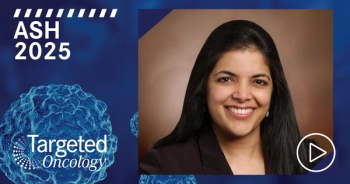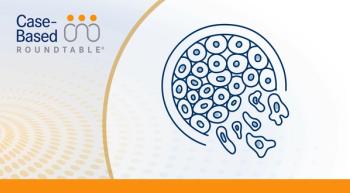
Combating Disparities in Access to CAR T-Cell Therapy and Clinical Trials
During an interview with Targeted Oncology, Lindsey S. Treviño, PhD, discussed how racial and socioeconomic disparities impact access to CAR T-cell therapy, clinical trials, and more.
Chimeric antigen receptor (CAR) T-cell therapy is one of the most important tools in treating hematologic malignancies, including leukemia, lymphoma, and multiple myeloma. However, there are stark disparities in which patients can get access to these vital therapies.
Socioeconomic and racial inequality already have a significant impact on cancer outcomes in the United States, often related to unequal access to treatment. In particular, African American and Hispanic patients are underrepresented in clinical trials that offer quicker access to experimental treatments and are needed to confirm they are effective in all populations. Socioeconomic status can determine who has access to more expensive treatment types, which includes FDA-approved CAR T-cell products. Patients who are already at a disadvantage in terms of survival outcomes suffer further by being unable to receive the latest treatments.
Countering these disparities requires special effort on the part of providers, according to Lindsey S. Treviño, PhD. This includes awareness of individual and structural barriers, as well as coordination with other stakeholders to address inequalities in the field.
During an interview with Targeted OncologyTM, Treviño, assistant professor, division of health equities, department of population sciences at City of Hope in Duarte, California, discussed how these issues impact CAR T-cell therapy, clinical trials, and more.
TARGETED ONCOLOGY: What are some of the disparities that you can highlight in the cancer space?
Treviño: Studies have shown that there are socioeconomic, racial, and ethnic disparities in access to CAR T-cell therapy. One example of this is that African Americans are less likely to receive CAR T-cell therapy, compared with other racial and ethnic groups. Layered on top of that is that African American and Hispanic patients are underrepresented in clinical trials in general, but [especially] for these CAR T-cell therapy trials.
These disparities in access and clinical trial representation are a major issue because we know that CAR T-cell therapy has revolutionized care for patients with blood cancers, such as multiple myeloma. We also know that African Americans have more than double the mortality rate of multiple myeloma compared with other racial and ethnic groups.1 What we're seeing here is a gap between the patients who are more likely to die from the disease and who would benefit from these therapies, but [due to] the gap to access, they're less likely to receive these therapies.
What are some of the ways that these disparities are being combated?
This is something that the field struggles with, because there are a range of structural barriers and social injustices that operate at the individual level, the level of the patient and the healthcare provider, but also at the systemic level, which is the entire healthcare system, and all our society and cultural beliefs. All of that combined drives this lack of clinical trial representation, and also the cancer disparities that we see. Overcoming these barriers will take all stakeholders in cancer research and care coming together to develop multifaceted approaches to address all these barriers.
It's not just [about] how can we get more people into the clinical trials, and then we've fixed it. There are also systemic societal injustices that we have to also address, which is beyond what a lot of people who do this research and who develop these therapies do on a day-to-day [basis]. We need to be thinking about working with other people in this space who may be addressing this, like community partners, patient navigators, and other people who are in the space, who may not be doing the research or treating the patients, but are in the community and can help make some of these changes that we need on all the levels where we see these issues.
What are some of the biggest updates in the CAR T-cell therapy space?
It's exciting to see where the field is headed, because we have all these developments of the next generation of CAR T-cell therapies which aim to improve on the efficiency of the current therapies, but also reduce toxicity, because toxicity is 1 issue that we have with some of these CAR T-cell therapies currently. We have all these new technologies and new approaches to make the next generation, which is exciting. The other thing that we're seeing is moving beyond the blood cancers. We see that CAR T-cell therapy has been efficient for targeting blood cancers. Now, researchers and clinicians are moving more into the space of solid tumors, which is complex. Cancer is complex in general but moving into solid tumors. It's a whole other ballgame.
It is exciting to see where the industry is headed in general, but my concern is that these cutting-edge therapies as they're being developed, will only be available through clinical trials, because we have to first test to make sure that they're safe before we can have them be FDA-approved. That lack of access to the clinical trials is an issue for some populations. This is a big problem that we need to address to ensure that these newly developed therapies will be safe and effective for all patients, and that there's equitable participation of all population groups in these trials as these cutting-edge new therapies come on board and are developed.
What are the key takeaways moving forward for community oncologists?
For any oncologist who is interested in learning more about cancer disparities and access to clinical trials and who may not be working specifically in the space that we're talking about now, I would highly recommend a report that came out from the American Association for Cancer Research.1 In 2022, they came out with a cancer disparities report, and it is a fantastic source for all the information that you might want to learn about different cancer types, what is the state of the field in terms of cancer disparities, which cancers are we seeing disparities in, and which populations. I have only mentioned African Americans and Hispanic patients up to this point, but they have addressed disparities in terms of rural [patients] vs those living in the city, different socioeconomic demographics, as well as those in the LGBTQ+ community. This is an excellent resource for any oncologist who wants to learn more about the cancer disparities. There are also some helpful tips in there in terms of strategies for reducing cancer disparities and what that looks like, in terms of how you treat patients and also thinking about prevention.
What else is important to add about this topic?
It's important to get the message out in terms of what we're seeing in cancer disparities in general. A lot of it is just not knowing. You don't know what you don't know, right? So, bringing attention to this issue, and talking about it and trying to brainstorm ways that we can all work together to address them, is important, and therapy is just 1 small aspect of it. We can also think about prevention, and access, and survivorship. It's a whole ecosystem of things that must be addressed in order to eliminate these cancer disparities that we see in and make sure that people survive with cancer.
Reference:
1. AACR Cancer Disparities Progress Report 2022. American Association for Cancer Research; 2022. Accessed July 19, 2023. http://www.CancerDisparitiesProgressReport.org/









































